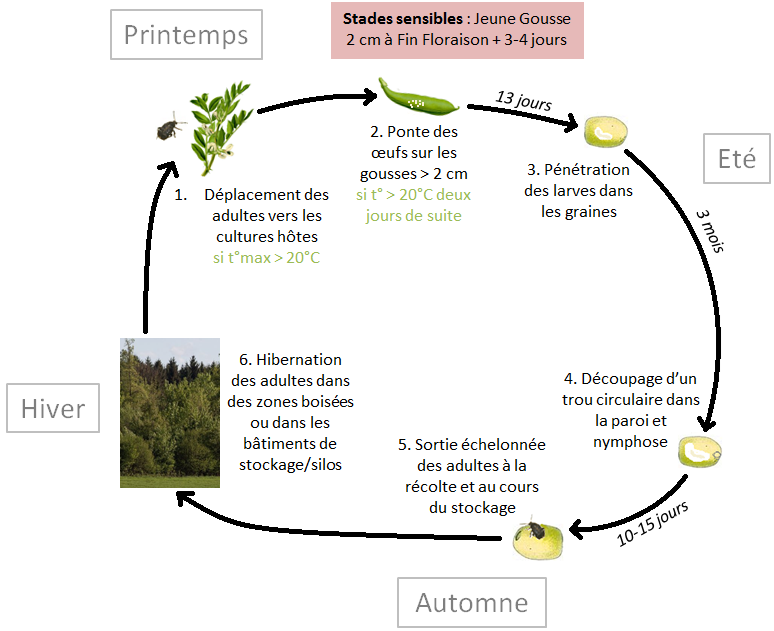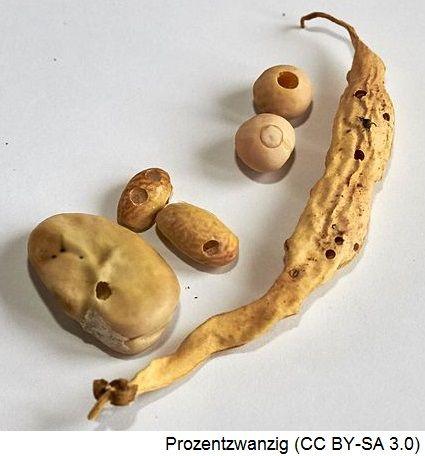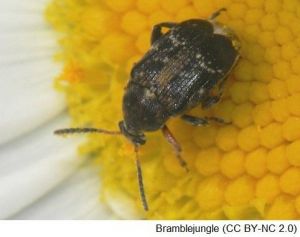Bruchus rufimanus
1. General description
| Geographical area | In France, all faba bean production areas are affected. |
| Crops affected | Plants of the Vicia genus, with faba bean(Vicia faba) being its main host. According to Herbea, chickling vetch(Lathyrus sativa) is part of the bruchid 's "host tribe" (see bibliography). |
2. Biology and epidemiology
Biological cycle

Conditions favourable to development
| Environment | / |
| Climate | Bruchids are active from 20°C and temperatures close to 25°C are very favourable. |
| Cultivation history of the plot | Areas at risk are those that were attacked the previous year. According to Agroscope, an interval of less than three years between two bean crops favours bruchid attacks. |
| Plot environment | Bruchids overwinter as adults, but we do not know exactly where they overwinter. The situations at risk are grassy and wooded environments and plots sown close to seed storage silos. |
3. Damage
Symptoms and damage
In vegetation, white-yellow eggs a few millimetres in diameter can be seen on faba bean pods. At harvest, circular holes in the seeds are the most obvious sign of bruchid attack (see photo below, bruchid holes on different seeds and pods), but theinsect can also cause spots on the seeds.
The presence of bruchids in seeds has little impact on yield, but reduces the germination rate of seeds (even if the germ is not affected, damaged seeds are more susceptible to root diseases at the start of the cycle) and presents risks of re-infestation during cultivation. For marketing purposes, zero tolerance is applied to the presence of liveinsects. There are also thresholds for bruised grains that must not be exceeded (1 to 3% for human consumption, 10% for animal consumption).

Nuisiblity
(to be completed)
Measuring systems
Existing bruchid trapping systems are not very effective.
==== Bruch-LIS ==== is an agro-meteorological model that makes it possible to position insecticide treatments for bean bruchids as effectively as possible, depending on the crop's stage of development, climatic conditions and product persistence.
4. Management methods
Existing solutions
Diagram : Positioning of the various pest management levers (Source : Ecophyto plan Concept tool)
| Mode of action | Lever | Description | Effectiveness |
| Action on the initial population | According to the Swiss institute Agroscope, an interval of more than three years between two faba bean crops is sufficient to control the bruchid. | (to be completed) | |
| Conservation control | Biological control | Flea beetles have natural predators, including a microgae from the Braconidae family that lays its eggs in the larvae developing in the seed. | Respecting these auxiliary insects does not prevent the larvae from penetrating the seeds, but it does help to prevent bruchid outbreaks in crops. |
| Catch-up solution | Chemical control | In crop production, insecticide control only targets the adults, as the larvae take shelter in the pods and then the seeds as soon as the eggs hatch. The range available is limited to pyrethroids (or pyrethrum in organic farming). | The products available are only partially effective. Bean is a crop visited by pollinating insects, so be sure to comply with bee legislation ! |
| Action on the initial population | The Swiss institute Agroscope recommends burying seeds that have fallen during harvesting. | ? | |
| Action on the initial population | Chemical control | After harvest, application of deltamethrin and piperonyl butoxide (contact insecticides). | Nearly 100% control of adults emerging from seeds, ineffective on larvae. |
| Action on the initial population | Chemical control | After harvest, phosphine fumigaton by an approved operator in a sealed silo. | 100% control of adults and larvae |
| Action on the initial population | Physical control | After harvest, hot air drying (50-70°C depending on duration). | Good on adults and larvae. Drying too quickly or too hot may damage the seeds and impair their visual appearance. |
| Action on the initial population | Physical control | After harvest, freeze batches. | Ineffective : lowering the temperature of the grains preserves them but does not control bruchids. |
Rem : collective control is desirable within a production basin, as bruchids can fly far and wide.
Innovative solutions
Susceptibility to bruchid attacks is genetically determined. In 2016, resistant cultivars were identified by INRA Dijon, whose genes of interest could eventually be isolated and then introgressed into faba bean varieties of agronomic interest.
Since 2011, a team from INRA Versailles, in collaboration with Arvalis - Institut du végétal and Terres Inovia, has been working on the development ofattractants based on compounds derived from faba beans. These attractants enable bruchid moths to be trapped in the field on sticky leaves containing small vials of the olfactory mixture. The effectiveness of trapping seems to have been validated after 2 years of experimentation, and the first field devices were tested in 2016 in Seine-Maritime.
Biocontrol trials involving the application of infradoses of fructose to plants are also being conducted in the field by Arad2 (CERFrance Normandie-Maine's regional agronomy and sustainable development workshop). These homeopathic doses of sugar send a signal to the plant to mobilise its own defence mechanisms.
5. To find out more...
| Title | Type of document | Year | Authors | Publishers | Précisions |
| e-phytia page : Broad bean beetle | Website | 2017 | INRA | INRA | link vers le site |
| ABAA database : faba bean bruchid | Website | 2017 | EcophytoPIC | ACTA | link to the website |
| Bean leaf beetle | Website | 2017 | Herbea | Solagro | link to the website |
| Bean bruchid | Website | 2017 | Arvalis - Institut du végétal | Arvalis - Institut du végétal | link to the website |
| Bruche : perforated seeds | Website | 2017 | Terres Inovia | Terres Inovia | link to the website |
| Bean : experimental solutions against bruchid infestation | Press article | 2016 | Cultivar 68, p.6 | ||
| Bean leaf beetle on faba bean : chemical messages deciphered | Press article | 2015 | B. Frérot (INRA), E. Leppik, P. Taupin (INRA / Arvalis), M. Lefranc (Arvalis) | Perspectives agricoles 419, p. 60-62 | link to article |
| Controlling bean leafhoppers in storage | Technical brochure | 2015 | N. Blosseville (Terres Univia), S. Dauguet (Terres Inovia) | Terres Univia, Terres Inovia | link to the brochure |
| Integrated control of bean and pea flea beetle | Engineering thesis | 2007 | L. Salles | ENITA Clermont-Ferrand, Arvalis, UNIP |
Appendices
S'attaque aux cultures
